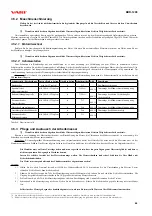
BDR-1200
2.5.4.2 Tightening pulleys adjustment
Seek authorised service in case you lack appropriate manual skills.
Ref a): According to Fig.12: Dismantle the upper gearbox cover (1). Adjust the wire of the wheel drive clutch tension pulley so that the pulley
stretched the gearbox drive belt sufficiently (adjustment screw 2 on Fig.12). If the pulley hits the driven pulley on the gearbox, the belt must be replaced!
Ref b): According to Fig.13: Dismount the cutting mechanism plastic cover so that you can see both belts (6 and 7) and the disc drive pulleys (4 and
5).
1)
If the V-belt creeps (7) between the double pulley (2) and the driven pulley (3) on the left gearbox, check the V-belt for damage or wear,
and the V-belt tensioner (5) for correct function. Replace worn-out V-belt, grease the tensioner arm seating faces with plastic lubricant and
replace functionless gas strut.
2)
Check the V-belt (6) between the engine (1) and the double pulley (2) on the cutting mechanism for wear or damage. Adjust the tension
pulley cable wire so that the tension pulley (4) stretched the belt sufficiently (adjustment screw 3 on Fig.12).
3)
Also adjust the cable of the cutting disc drive automatic brake (9) (see 1.5.4.3 Checking the function of cutting disc automatic brake and its
adjustment), so that the cutting disc automatic brake was released sufficiently before the cutting disc drive tension pulley begins to mesh.
➢
If the bolts cannot be unscrewed or screwed in any further, screw them in completely and hook the spring at the end of the cable into the further
opening in the pulley arms or the brake cam.
Always check the automatic brake function after every cutting disc drive adjustment!
2.5.4.3 Checking the function of cutting disc automatic brake and its adjustment
Check the automatic brake function after every 10 hours of use. (You can check it during operation.) Every time you release the disc drive
clutch lever, the automatic brake must stop the spinning disc within 7 sec.
Do not continue working with the cutter unless you remove the automatic brake damage.
Seek authorised service in case you lack appropriate manual skills.
In case the brake does not stop the cutting discs in the given time span, it is necessary to adjust the brake cable (9 on Fig.13). Screw the adjustment
screw (4 on Fig.12) which fastens the brake cable to the frame of the machine, against the direction of the arrow (towards the frame), so that the axial
clearance of the brake cable in the adjusting screw was 1 mm. Check the automatic brake function. If complete tightening the screw (4) does not offer
adequate brake effect, tighten the adjusting screw of the brake cable on the handlebars so that the axial clearance of the brake cable in the adjusting screw
was 1 mm. Check the automatic brake function
If, after the adjustment
, the brake does not work properly, contact an authorised service center.
2.5.4.4 Adjustment of the wheel drive automatic brake
Automatic brake is activated by releasing the left handlebar wheel drive lever. Correct function of the automatic brake is checked by letting the
machine go on a 30°-gradient slope, and the machine shall stop after releasing the wheel drive clutch lever. A suitable slope means such slope, length of
which does not exceed 5m, and where is sufficiently large free space under the slope for potential landing of the machine due to its inertia.
Pay special attention when checking the automatic brake function. Banish all people or animals from the space in front of the machine.
With regard to the weight of the machine, check and adjust it in a team of two, at least.
Check the automatic brake function after every longer putting the machine out of operation!
Adjustment process of the automatic brake:
Place the machine on a suitable slope with the drive wheel clutch lever on the left handlebar off. Tighten the automatic brake nut (3 on Fig.14) behind
the left wheel so that the machine remained on the slope and did not continue driving downhill. Keep releasing the automatic brake nut slowly, until the
machine starts moving. Then tighten the nut by 1/2 revolutions. When the drive wheel clutch lever is released, the cable must have axial clearance of
approx. 2 mm. Adjust using the adjustment screw (5 on Fig.15).
Automatic brake adjustment check:
When the drive wheel clutch lever is pressed and the machine is on neutral, it has to drive down the slope, and when the drive wheel clutch lever is
released, the machine must stop. If not, tighten the nut slightly and try again.
2.5.4.5 Directional brakes adjustment
Adjustment proceeds by tensioning the cable by unscrewing the adjustment screw on the left and right directional clutch lever (15 and 16 on Fig.6).
Always adjust both direction brakes so that the intensity of the braking effect was same for both brakes. The brakes should brake sufficiently when the
lever is pressed in approx. ½ of the total stroke of the lever. The function to be tested on a level surface at test rotation by 180° at 3rd speed gear. However,
the brakes must not brake the machine in forward drive (output losses, overheating and wear of the directional brake lining). To be tested by manual push
of the machine at neutral (“N” on Fig.11) and the wheel drive clutch lever (2 on Fig.11) pressed.
54
The steps can be performed in opposite sequence - first screw in (towards the handlebars) the brake cable screw on the handlebars to achieve the axial clearance of 1mm
in the adjustment screw.
55
The condition of the cable axial clearance in the adjustment screw is met.
27
















































